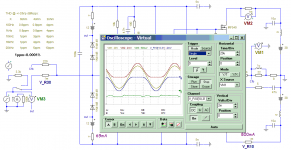Hey what kind of ign system Wave.... The Key is for standby Power...
The Key is for standby Power... 
Here is the amp that kills the myth about "tube sound is the result of high low order distortions and low damping factor":
http://www.diyaudio.com/forums/club...festival-audio-happening-124.html#post1636391
No wonder you don't have one,, deh wife would never allow that in her house...
You are wrong. My wife is actually spoiled by their sound, and would like to have some at home.
OK, when you get one to replace the Denon let me know ....
It is hard to tell, I took a job of a System/Network admin to have some money for living. No time for projects.
Can you explain , why GU50 tube and not say KT88/KT120 and whatever happened to the 6LQ6 type power tubes..?
Yes, if you can explain, why crappy non-linear steam engine age 6L6 clone instead of designed by Telefunken much more linear LS-50 pentode.
Maybe because they still driving them with 12AX7 .....
No. Because Gu-50 look like trash cans. And were unobtanium for manufacturers of mass production of guitar and hi-fi amps when everything, from crap to jewels, was made on tubes. LS-50 was designed and manufactured by Telefunken for military and government applications. Later after WW-II it was captured and redesigned for Soviet military applications, like aircraft transmitters. The tube requires more precision equipment to align grids, and uses more expensive materials, like nickel alloy for anodes. That's why after being red dissipating 100+W shortly it still works as if it never happened.
Last edited:
That is not always true and not a surprise, my N2 has low feedback and only 9 transistors including the power mosfet and its current source, it could operating also with 8transistors in total. There are no easy way to get stable high NFB that could reach 1ppm THD and less, with only 7 transistors driving mosfet output. Low distortion in solidstate isn't always high feedback but the output stages could be linearized with good design.And one more surprise: I've found that smoothness of transfer function means lower distortions than it's linearity. I.e. attempts to improve quality of an amp with smooth transfer function by decreasing of distortions applying feedback makes transfer function more linear but less smooth. It decreases THD, but increases audible distortions.
Why need 1ppm? because it need to work as linear current amplifier that has linear forward and reverse transfer. 1ppmTHD V-amp results in around 0.01%THD I-amp (depend on I sense resistor used). 0.01% THD is the margin that my ears start to hear differences for H3 and up, H2 is 0.02%.
In N2. It just have crossover distortion rises when operating in 10kHz and up with high current 2ohm load.
Attached shows 800mA biased N2, crossover at 10kHz is only in micro volts. I am choosing 200mA because that crossover distortion is already inaudible in around 100mA. Test is also easily do with biasing switch.
You know? This kind of buffer (I call it power gain in the past, but not a good name) has linear load transfer from output to input that makes it sounds like what is at the input.
Attachments
It's interesting that J. Gordon Holt, who was one of the early and most influential proponents of "tube sound," described it as bright and forward, not soft and warm.
Listening to pentodes was he?
With copious feedback was he?
So, there was no reason that he thought this... heh
_-_-bear
Marantz was pentodes? Dynaco? Fisher? Quad? Leak? Luxman? (just to name a few power amps he reviewed back in the day)
For preamps with which Holt was intimately familiar, I can't think of any that were pentodes.
wouldn't matter much what preamp you used if ur power amp 'spits' in the upper mids, lower highs?
...besides, when has anyone published a negative review in a mainstream hifi rag?
_-_-bear
Careful, SY, you are being inaccurate in your statement about triodes vs pentodes (or beam tetrodes). For example, Marantz COULD be connected to triode with a switch, but it was usually used in 'Ultralinear' which is equally triode and pentode.
In 1965, we used to modify Fisher 500C receivers to triode operation, from PENTODE operation. Dyna was Ultralinear, and could be beat sonically by either Radiocraftsman (triode) or Marantz 9 in triode mode. Even Ultralinear is not perfect, just a good compromise between power and performance.
In 1965, we used to modify Fisher 500C receivers to triode operation, from PENTODE operation. Dyna was Ultralinear, and could be beat sonically by either Radiocraftsman (triode) or Marantz 9 in triode mode. Even Ultralinear is not perfect, just a good compromise between power and performance.
Gordon Holt never published a negative review? Are you kidding?
Irrelevant anyway, here was a guy who INVENTED so-called subjective reviewing and had far more experience and knowledge than anyone else doing it, then or since. So how do you explain away the change in the perception of "tube sound?" Or was Holt effectively deaf?
Irrelevant anyway, here was a guy who INVENTED so-called subjective reviewing and had far more experience and knowledge than anyone else doing it, then or since. So how do you explain away the change in the perception of "tube sound?" Or was Holt effectively deaf?
Careful, SY, you are being inaccurate in your statement about triodes vs pentodes (or beam tetrodes). For example, Marantz COULD be connected to triode with a switch...
Oh, OK, Gordon Holt didn't know how to use a switch. Never listened to a triode amp. Sure.
How many Fisher 50A did you modify to triode?
- Status
- This old topic is closed. If you want to reopen this topic, contact a moderator using the "Report Post" button.
- Home
- General Interest
- Everything Else
- Electronic Design Mag discovers High End Audio!

